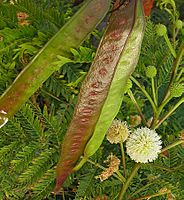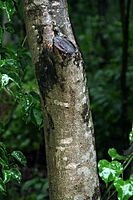Mauto facts for kids
Quick facts for kids Lysiloma divaricatum |
|
|---|---|
 |
|
| Conservation status | |
| Scientific classification | |
| Genus: |
Lysiloma
|
| Species: |
divaricatum
|
| Synonyms | |
|
|
Lysiloma divaricatum is a type of flowering tree. It grows naturally in Mexico and Central America. People call it by many different names. In Mexico, it's known as mauto, quitaz, or tepemesquite. In Honduras, Mexico, and Nicaragua, it's often called quebracho. In El Salvador, you might hear it called quebracho negro, tepemisque, or yaje.
Contents
What Lysiloma divaricatum Looks Like
This tree is usually small to medium in size. It has many branches that spread out. Its top part, called the crown, is open and wide. The tree can grow up to 15 meters (about 49 feet) tall.
Where Lysiloma divaricatum Lives
Lysiloma divaricatum grows in a wide area. You can find it from northern Mexico all the way down to Costa Rica.
Its Favorite Places to Grow
This tree likes warm, dry places. It lives in dry forests where trees lose their leaves in the dry season. It can also be found in mixed pine forests. Sometimes, it even grows in desert areas with cacti.
It can live from sea level up to about 1,100 meters (3,600 feet) high. Sometimes, it's found even higher, up to 1,750 meters (5,740 feet). This tree often grows on hillsides. It prefers soils that are volcanic or made of sandy clay.
Plant Neighbors
In some areas, like Baja California, it often grows near a plant called Caesalpinia pannosa. In other dry forests, it shares its home with trees like Chloroleucon mangense, Leucaena macrophylla, and Senna mollissima. It also grows alongside different types of Acacia, Parkinsonia, Calycophyllum, Mimosa, and Myrospermum trees.
Gallery
How We Protect Lysiloma divaricatum
Scientists keep an eye on the number of these trees. The population of Lysiloma divaricatum is considered stable. This means there are plenty of them. Because it grows in so many places and there are many trees, it is listed as a species of Least Concern. This means it is not currently facing major threats.
See also
 In Spanish: Lysiloma divaricatum para niños
In Spanish: Lysiloma divaricatum para niños




